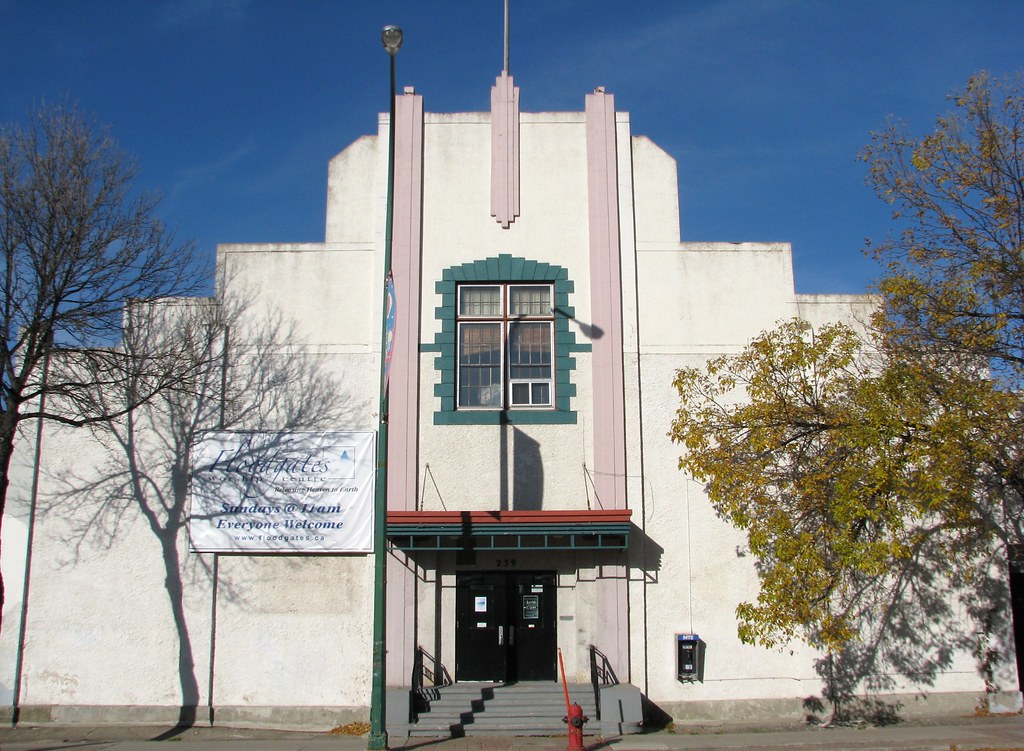Constructed: 1889
Architect: John W. Grieves
The land was purchased for $600 and architect John Grieves, a member of the congregation, was hired to design the building. The $2,899 construction contract was let to Bears and Read on July 2, 1889 and the first service was held here by Rev. John Hogg on December 1, 1889.
After just a few years the congregation had again grown too big for its church. A balcony was added but a larger space is what they needed.
In 1907, construction began on that new building at Burrows Avenue and Charles Street and the final church service was held here on March 8, 1908.
Source: Winnipeg 1912 by Jim Blanchard
The Hebrew Sick Benefit Association (HSBA) purchased the building and converted it into a hall and meeting rooms.
The HSBA was founded in 1906 and was one of several “mutual benefit societies” that provided social services to its members. Such societies were common, particularly in ethnic communities, in the days before a government social safety net that provided things like unemployment insurance, disability payments and funeral costs. The HSBA also maintained a cemetery on McPhillips Street.
Their plans for the building also included the creation of a theatre space, to be named the Queen's, for the the Yiddish Dramatic Club which offered home-grown, live theatre for the Jewish community ranging from simple skits to high dramatic works.
Drawings for the theatre conversion were submitted to the city in September 1908 and by early October events were taking place at the hall. The earliest ones noted in mainstream newspapers were a series of Liberal candidate rallies for the October 1908 provincial election. Other early events at the hall include union meetings and even wrestling bouts.
Aside from local events ranging from plays and teas to religious services and wedding receptions, the Queen's also hosted travelling Jewish theatre companies. International stars of the Jewish theatre such as New York-based actor / director Jacob Ben-Ami, actress Keni Liptzin and Austria's Rudolph Schildkraut, all tread the boards here.
December 8, 1934, Winnipeg Free Press
It appears that during the Depression the Queen's Theatre closed, though the hall and meeting spaces were still in use.
In December 1934, a two-alarm fire broke out on the mezzanine level which did significant damage to the roof. Both the Free Press and Tribune stories about the fire referred to the building as the "former Queen's theatre" noting that it had been empty for "some years". Earlier that year it had been rented to the Polish National Church.
At the time of the fire the building was vacant and the HSBA were studying options for its reuse which could have included converting all or part of it into housing. Its near-loss, however, seemed to reinvigorate interest in using it as a cultural space.
In January 1905, a building permit for $5,000 was issued to the HSBA to repair the building. In February A. Akman of Spruce Street began work which not only included rebuilding the damaged roof but the remodelling of the meeting spaces and auditorium, which presumably was the theatre interior.
It is believed that the renovation included the addition of the current art deco facade.
May 20, 1935, Winnipeg Tribune
On May 19, 1935, the hall was officially re-opened with a ceremony that included remarks from mayor John Queen and provincial attorney general W. J. Mayor.
Aside from the HSBA's space, the building became home to the Universal Athletic Club, General Monash branch of the Royal Canadian Legion - which was particularly active through WWII - and a confectionery shop. The hall was again the scene of countless dances, banquets and special religious services.
January 21, 1941, Winnipeg Free Press
In 1941, another two-alarm fire started on the balcony level and destroyed the roof. It was likely due to an improperly disposed of cigarette in one of the upstairs meeting rooms earlier in the night.
It was a close call for Charles Stewart, the live-in caretaker of the hall, his wife, Margaret, and their two-year-old child. They fled into the frigid night at 4:40 a.m. after calling the fire department. Their upstairs apartment was destroyed.
The building was repaired at a cost of $9,000 and was open in time for its annual "Queen Esther" fundraising festival in April. In 1943, it hosted western conference of Canadian Jewish Congress.
October 9, 1954, Winnipeg Free Press
Through the 1950s, the HSBA Hall was increasingly rented out to non-Jewish groups for use. (As with many ethnic groups, their members were moving out of their traditional neighbourhoods to the suburbs.)
The hall was rented on multiple occasions by the Canadian Peace Congress, Canadian Soviet Friendship Society, St. John's Bridge Club, the Labour Progressive Party and the Hong Kong Veterans Association. A groups called Champion rented it on October 11, 1954 for a concert by Pete Seeger who was early in his career as s solo folk singer.
In the 1960s, the HSBA merged with other organizations to form Beth Israel Synagogue in Garden City and the building began hosting regular bingos to support Beth Israel. This did not mean the end of the HSBA's activities. They still operated their cemetery and in 1971 opened HSBA Gardens, a retirement home on Sinclair Street.
In August 2002, Beth Israel, Bnay Abraham, and Rosh Pina synagogues merged to form Congregation Etz Chayim and the new organization inherited the HSBA Hall. After years of dwindling bingo revenues and difficulty finding volunteers to run it they sold the building in 2010.
The building came full circle as it was bought for use as a church: the Church of the Rock's North End Campus.









No comments:
Post a Comment